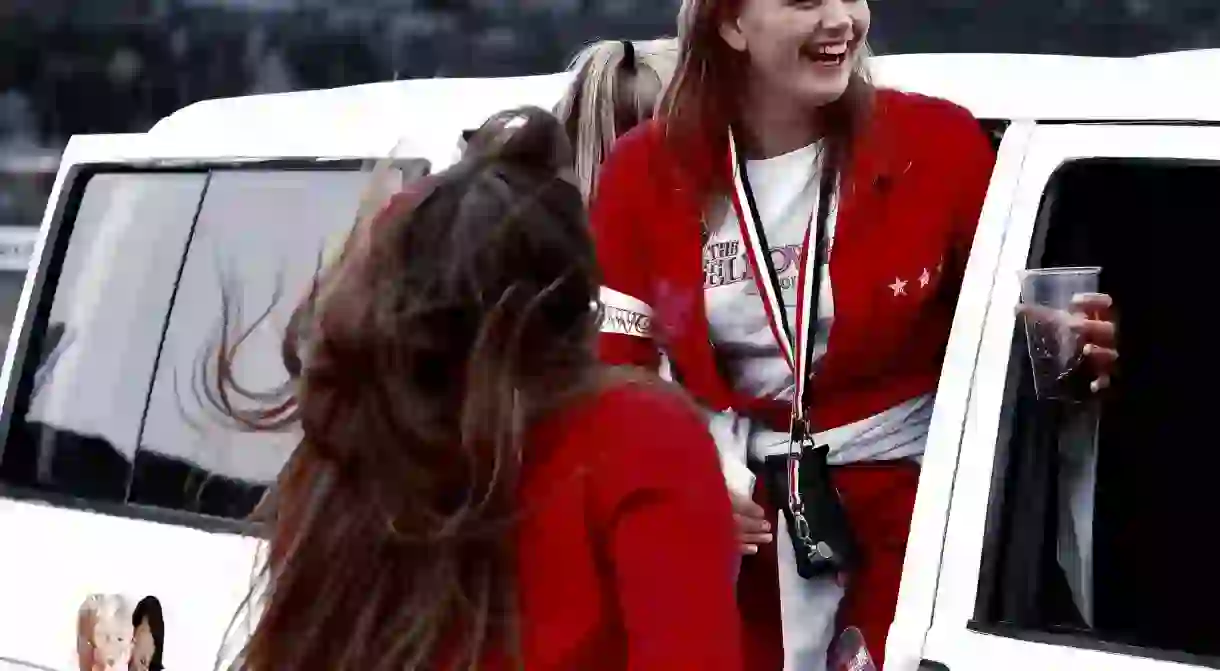A Glimpse Into Norway's Wild High School Graduation Celebrations

If you’ve ever watched Skam, then you know that russ (short for russefeiring) is a big deal in Norway. If you haven’t, just watch out for the youngsters with the red or blue overalls roaming the cities from mid-April until May 17. They’re celebrating their upcoming high-school graduation – and take said celebration very seriously. Here’s what you need to know about this wacky time of year.
It all began with a hat in the early 1900s
A cap, to be exact. Drawing inspiration from the German fashion of the time, red russ caps (russelue) became part of the graduation celebration from Norwegian high schools, marking the passage to adulthood and higher education. It was a time to celebrate. And, as most students turn 18 around that time (aka the legal age to consume alcohol), the celebration started becoming more and more exuberant over the years. The students would wear their traditional caps and overalls (russebukse) and they would party and drink from late May until early June when school was out. The overalls, nowadays purchased from the official website and personalized to death by students, reflect the type of studies they are completing. Red, which is the most common color you’ll see, means general education, whereas blue means financial and business studies.

All aboard the russ bus
In the 70s, the tradition of buying an old van or bus and painting it in the same colors as the russebukse officially started. The buses became both the base of russ operations and mobile parting units. By the early 00s, the authorities were worried about the impact all this partying and alcohol would have on the students’ grades, so the final exams in public schools were moved to early May. This was intended to force the students to prepare for the exams instead of partying, but what ended up happening was simply that the students started the russefeiring earlier. Nowadays, the russ period (russetid) kicks off April 11 and lasts until the National Parade of May 17. On that day, the students are awarded their caps and join the parade in their overalls.
Russetid is serious partying business. The buses have names and themes, and are equipped with such strong speakers and lighting that they’re practically nightclubs on wheels. Of course, the students are not driving themselves: there’s a (sober) hired driver, who usually wears noise-cancelling headphones to not get distracted by the music. As all this ends up being very expensive, groups of students get together and plan on how they will be able to afford everything (which was one of the main issues in Skam) very early on. They apply for funding from sponsors, whose logos will then appear on the bus. Some of them create high-school russ newspapers that are mostly satirical and contain the official knot rules for the school (we’ll get to that). There are meetings, preparations, strategies, planning… And as if the stress wasn’t enough, there are also competitions between groups about who has the best bus.
But when everything is ready, the partying begins. The students hop onboard the bus and head on to various festivals/russ meeting places (russetreff). Many have compared this phase to Coachella, if Coachella lasted a month and no one over 20 was allowed.

Challenge, accepted
But the partying isn’t even the wackiest part of russefeiring. The graduation cap plays a key part in the russ tradition, as its long cord needs to be decorated with knots (russeknuter) before graduation day. Russeknuter is something you earn by completing dares from the russ-knot list: originally introduced in the 40s, the list is different for every school. Mostly meant in good fun, the dares on the list may have students wearing loaves of bread on their feet for a whole day, or barking at people at the supermarket. But in the last decade or so, knot dares are increasingly becoming rougher, including the consumption of alarming amounts of alcohol (24 drinks in a day) or nudity and sex in public places.
That last aspect of russ is making an impact in Norwegian society. For example, one school’s dare asks for students to run naked over a 1.4-kilometer bridge that crosses a lake. That might not be dangerous to the students themselves but, according to Terje Moe Gustavsen, director of the Norwegian Public Roads Administration, “people driving could get such a surprise if they see naked people on the bridge, they might forget they are driving.” And then there was a dare for students to have sex on three different roundabouts in the area, which Gustavsen advises against, as it would pose a traffic hazard. It is interesting to note here that the Norwegian Public Roads Administration does not approach the subject from a moral perspective, but from a completely practical one, urging students to pick challenges that are safer. Perhaps due to incidents like this, lately some “good” challenges (like helping a homeless person or supporting a charity) have also started appearing on the russ-knot lists.
Good or bad, once a knot challenge is completed the students tie trinkets to their caps that represent each “knot”. So if you see students with condoms on their hats, that means they have completed the challenge of having sex in public. We hope it wasn’t on a roundabout.

Ultimately, russefeiring is optional. There are some students who, for personal or religious reasons, feel like it’s not for them. The russ period has also become known as “the three-week binge” (treukersfylla) and some groups of students choose to partake in more sober versions of it instead. But as far as the largest part of the teenage population in Norway is concerned, from mid-April to mid-May, it’s their right to party. Feel free to wear noise-cancellation headphones at night.













